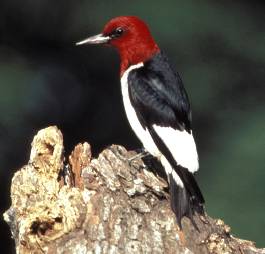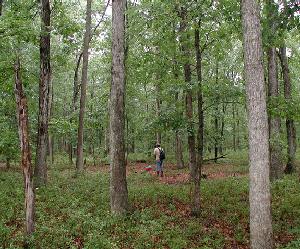Red-headed Woodpecker - December 2003 Species of the Month
|
This woodpecker is typically seen perched on tree
trunks or limbs and its brightly colored red head can be thought of as
festive decor against an evergreen background for the winter holiday season.
|
|
|
The red-headed woodpecker was a common species throughout
the Northeast during the late 1700s through the early 1900s. Large concentrations
of these birds, including flights of several hundred, were observed often
during fall migration. During the past 50 years or so, counts of only
two to eight birds were recorded as part of the annual migratory bird
counts conducted by bird enthusiasts in Cape May. Decreasing numbers were
also noted in other annual bird counts in the Northeast and it became
evident that the red-headed woodpecker had suffered significant population
declines in the past century. It was listed as a threatened species in
New Jersey in 1979.
|
 Photo courtesy US FWS
Photo courtesy US FWS |
| The Red-headed Woodpecker (Melanerpes
erythrocephalus) was the December Species of the
Month, in honor of the 30th Anniversary of the New Jersey Endangered
Species Conservation Act and the formation of DEP's Endangered
and Nongame Species Program (ENSP). It was
the final species of the month in a series of 12 that have been highlighted
to celebrate this special anniversary year. |
|

Red-headed Woodpecker with food for young at nest
in Pinelands
Photo by J.A. Spendelow, courtesy of USGS Patuxent Wildlife
Research Center
|
|
Red-headed Woodpeckers Hanging
On
("Knock on Wood!")
- Red-headed woodpeckers range from southern
Canada to the Gulf Coast, east of the Rocky Mountains and west
of New England. Scientists believe that the migratory patterns
of this species are driven by the availability of winter foods.
In general, woodpeckers residing "up north" move south
during the winter months.
- By the turn of the 20th century
red-headed woodpeckers in the Northeast had suffered population
declines due to road mortality, competition with European starlings
for nesting cavities, and harvesting for the fashion trade (many
avian species were killed to provide feathers for women's hats).
Farmers also killed them because they damaged fruit and berry
crops.
- More recent population declines resulted
from habitat loss, road mortality and limited availability of
nesting sites. Loss of breeding habitat and regional population
declines in the Northeast led the National
Audubon Society to recognize the red-headed woodpecker as
a species of special concern since 1982. It is considered to be
a rare species throughout the Northeast.
|
|
|
Red-headed Woodpeckers – Facts
of Interest
- The adult red-headed woodpecker is a robin-sized
bird with a bright red head, throat and neck. The belly, undertail and
rump are white. The species has a black tail, back and upperwing and
a thin black stripe that runs between its red head and white belly.

- This species of woodpecker inhabits woodland areas
that contain dead or dying trees. Red-headed woodpeckers in southern
New Jersey are found in mixed oak and pine forests that have a ground
cover of huckleberry or blueberry. Those in northern New Jersey are
found in upland or wetland forests. Preferred wintering areas include
orchards and pine forests.
- Red-headed woodpeckers are foragers typically seen
on tree trunks and limbs. Their diet includes fruit, nuts, seeds, insects,
small vertebrates, bird eggs and small birds. Unlike other woodpeckers,
they rarely drill holes into wood for food. Instead, they gather nuts
from the ground and store them in tree holes and crevices, fly through
the air to catch insects, and collect insects from beneath bark and
foliage.
- Like other woodpeckers, the red-headed woodpecker
has two toes on each foot that point forward and two that point backward.
This arrangement of toes enables it to cling vertically to trees. In
addition, the tail feathers are stiff and pointed, which help prop the
woodpecker up against the side of the tree.
|
| Ways You Can Help |
|
- As long as standing or collapsed dead trees or
decomposing logs provide no hazard to nearby structures, people, roads
or parking lots, consider allowing them to remain, as they may provide
critical nesting habitat and foraging opportunities for red-headed woodpeckers.
- Enjoy bird watching and birding? The DEP's Endangered
and Nongame Species Program has joined up with the New
Jersey Audubon Society to implement The New Jersey Important
Bird and Birding Areas Program. This project will enlist the help
of volunteer citizen scientists to identify and help protect a network
of priority locations that must be conserved in order to sustain healthy,
diverse bird populations. For more information visit the New
Jersey Audubon Society's website about this program.
- Participate in the National Audubon Society's
Christmas Bird Count! To learn more about this annual December activity
and how it is being implemented in New Jersey this year, visit Audubon's
website for this activity.
- Want to volunteer? Enjoy giving presentations?
Looking for speakers? The Division of Fish and Wildlife offers two opportunities:The
Endangered and Nongame Species Program's Speakers
Bureau and the Division's Wildlife Conservation
Corps. Visit these sites for details.
|
|
|
Order a
Conserve Wildlife special interest license plate for your vehicle. It's
tax-deductible, with 80% of the payment benefiting New Jersey's Endangered
and Nongame Species Program. |
|
Want to learn new information quickly about New Jersey
wildlife? The Division of Fish and Wildlife offers eight E-mail "mailing
list" choices to the public. Visit the E-mail
List Subscription Page to learn more about this free service and how
to sign up.
|
|
|
| Additional
Sources of Information |
|
|